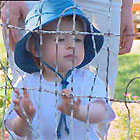Scott Cam excelled himself with this magnificent chook shed! It’s the centrepiece of our makeover and appears as if it has been there for a hundred years.
Chook pen details
Size:
4.4m wide x 2.7m high
Materials:
recycled hardwood posts (90x90mm); recycled cypress pine flooring for wall cladding (140x19mm); recycled oregon for bracing and framing (140x45mm); recycled oregon rafters (90x45mm); treated pine battens (70x35mm); blueboard sheeting; recycled terracotta roofing tiles (‘Marseilles’). (Scott’s tip: choose secondhand timbers carefully to avoid pieces that are warped or bent. Scott suggests buying a few extra so you can toss the bad ones away.)
Construction:
recycled hardwood was used for in-ground parts of the structure, with recycled softwood (oregon) for the rafters and bearers. The chicken coup has a pitched roof, finished with recycled terracotta roofing tiles. (Note: as pitched roofs can be tricky to construct, Scott recommends a flat roof for the home handyman.) French-inspired decorations were added, along with nesting boxes (fruit boxes) and perches for the chickens.
Tools for the job:
tape measure
pencil
spray marking paint
string line
spirit level
carpenter’s square
post hole digger
hammer or nail gun
hand saw or power saw
power drill and bits
spanners
How it was done:
After clearing away vegetation and rubbish, the area was levelled. The position of the chicken coup was marked out using a can of survey marking paint and string lines.
All structural and framing members were cut to the required lengths. (Tip: measure twice, cut once!)
Post holes were dug using a bobcat with an auger attachment (a scissor shovel will also do the job). The posts were then concreted in place with rapidset concrete.
Roof members were framed up, including wall plate, ridge, rafters and fascias. (Tip: nail wall plate to secure, then bolt in place with 10mm galvanised cup-head bolts. It is also a good idea to ask a friend to help you with the roof timbers.)
Scott lined the rafters externally with blueboard, then skew-nailed tile battens over the blueboard into the rafters at intervals to suit the size of the tiles. The roof was tiled and the ridge tiles were pointed up with cement.
Cladding for the chicken pen was old cypress pine flooring. No attempt was made to butt the flooring up tightly, and split and broken bits of flooring were incorporated to fit in with our rustic theme.
Scott showed off his bush carpentry skills by cutting the openings for the windows and door with his chainsaw (don’t try this at home!). Secondhand oregon offcuts were used to frame the windows and doors, which were then clad with recycled floorboards and hinged into place. A secondhand window on the right side of the shed provides light and ventilation for the chooks.
At the front of the building, an exposed beam appears to come up out of the ground to the ridge – this is actually nailed to one of the posts. It is purely decorative, allowing us to hide joins and other rough parts of the structure.
Don created a run for the chickens using old chicken wire, which he pulled around and nailed to the old fence posts with fencing nails.
Finishing touches:
All the lovely old bric-a-brac added to the front of the shed adds to its appealing rustic farmyard character. Hand-forged hinges, found at a demolition yard, make a superb feature on the door and window. An ancient padlock rests on the door but the ‘piece de resistance’ is the rusted tin chook standing proudly on top of the shed roof!
A small pathway of sandstone flagging between the gate and the shed door keeps feet clean, particularly on wet mornings when collecting the eggs for breakfast. On each side of the shed is a roof overhang where firewood for the home is stored.
One lemon scented myrtle (Backhousea citriodora) tree was planted each side of the shed as well as a lemon tree inside the run. A large cast-iron water pump, also found on a farm, was painted with an oxidising paint (such as Porter’s Instant Rust) to give it a rusted look, and then placed within the chook run. The old wire gate completes the look, not only enclosing the run for the chickens but also providing a safety net for wandering toddlers.
For a French country-style makeover with a chook shed as its centrepiece, we needed suitably French-style chooks, and the Faverolles breed is ideal (see our road test). Faverolles really are a great choice for this makeover, not only because of their French accent, but also because they are a great beginner’s chook, and very good with kids, too.
Further information
60m of recycled chicken wire costs around $60
2440mm x 1200mm x 7.5mm blueboard sheeting costs $45, from hardware stores or visit the website: www.jameshardie.com.au
Recycled ‘Marseilles’ roof tiles cost $2 each



